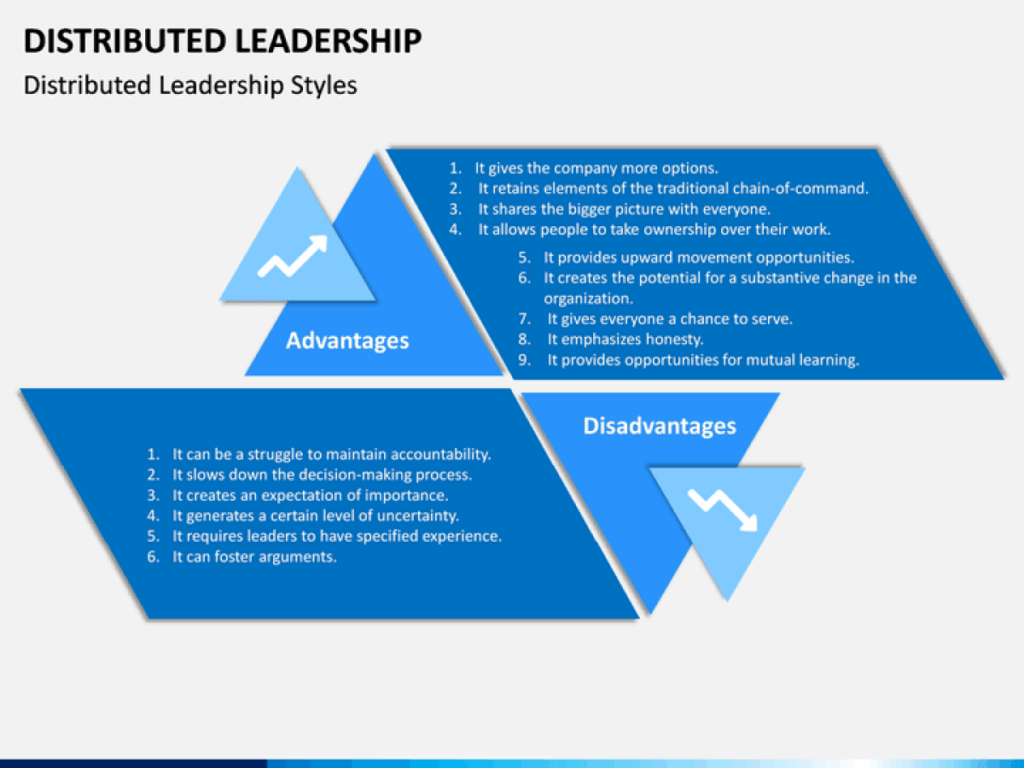What is distributive leadership in education?
In this guide
What is distributive leadership?
Distributive leadership is the idea that the leadership of an organization is “distributed” across multiple people instead of just one leader doing all of the work.
Decisions are made with individuals across the organization participating in the process. It is not about one person controlling everything that happens. This form of leadership is not about leaders developing consequences and punishments for those they lead, but about working together to create systems and procedures for the organization.
In contrast to traditional leadership, there are multiple people that work together to make decisions. A collective mindset and system of synergy must be cultivated within an organization that uses the distributive leadership model.
This is a way of creating a culture within an organization that values creativity, cooperation, and success. Distributive leadership allows for multiple viewpoints to be used to solve problems and for multiple voices to be heard.
The concept that more than just one person (or a very small group of people) can lead an organization successfully is the idea behind distributive leadership. More voices are part of discussions and more voices make decisions that impact everyone.
How can it be used in education?
Distributive leadership in education is a system where principals, other leaders, and teachers share the leadership load in a school. In this type of leadership style, the principal is not the sole individual in charge of decision making.
This often takes the form of an instructional leadership team. These teams can be composed differently from campus to campus, but they usually include teachers from across the campus and contents, the principal, assistant principals, program coordinators, and sometimes a member of auxiliary staff such as a secretary.
These instructional leadership teams work together to make decisions for the campus. They set goals and determine the steps needed to accomplish those goals.
On the campus where I work, we have an instructional leadership council. As a department chair, I am a member of this committee. We have set a specific goal for the year and have worked out the steps it will take for us to accomplish this goal. We also work together to make smaller decisions like policies and procedures that are put into place around the campus.

This committee is made up of the principal, assistant principals, and teacher leaders. Our school is a brand new school this year. We have not had time to develop culture yet. Together we are developing the school culture, goals, systems, and dynamics that will shape the future for the campus.
This could all be done by the principal alone. However, everything would be his culture, goals, systems, and dynamics. Distributive leadership allows for the voice of teachers to be heard and for the needs of teachers and students to be addressed.
Schools are not going to stop having a leader such as a principal. The school community needs someone at the helm. However, when a school participates in distributive leadership it results in shared leadership. Yes, the principal is still in leadership, but the role of others increases. All responsibility for decision making is not on the shoulders of one individual.
Collective decision making is what distributive leadership looks like in the school setting. It removes the pressure to make all decisions from one person and distributes the pressure throughout a group. Distributive leadership is shared leadership that recognizes the strengths and skills of others.
When using distributive leadership in the school setting there are some systems that improve its success.
- Developing trust is incredibly vital to the success of this leadership system. The principal must trust the leadership team and the leadership team must trust that the principal will not simply override all of the decisions made by the group.
- Transparency is also important for success. Members of the leadership team must be willing to be honest and to bring forth concerns and questions. Decisions that are made must be collective and supported by the group.
- Data is important for successful distributive leadership in the educational setting. In order to determine if instruction, goals, and vision are being realized and effective, data must be collected and analyzed.

Benefits of distributive leadership for schools
Distributive leadership in the educational system helps to create school communities that work together.
One benefit of distributive leadership within schools is that the principal does not carry the sole responsibility for making decisions. Decisions are made by multiple individuals working collectively for the good of a school.
Another benefit of distributive leadership is shared vision and goals. Instead of the principal setting all of the goals for the campus, the leadership team can set goals together. When one person makes goals, not everyone agrees with fulfilling those goals.
Teachers in leadership positions can create goals that are appropriate to the campus and students they teach. Teachers are in the classroom everyday. They know what is needed and what factors impact student achievement. When teachers are allowed to be part of the decision making process, they are able to voice concerns and develop creative ways to address them.
Accountability is also a benefit of this leadership style. When a group makes a collective decision or sets a goal together, accountability is required for success. Without accountability, goals are not reached.
When distributive leadership is used in a school setting, the principal is not solely responsible for reaching goals. The leadership group creates the goals and the steps needed to accomplish those goals. Responsibility is not on the shoulders of one, but on the shoulders of many.
Advantages and disadvantages
There are advantages to distributive leadership, including the concept of collective efficacy. Collective efficacy is the idea that teachers can work together, recognize their ability to influence student success, and use that ability to actually increase student achievement.
When teachers are a part of the leadership of a school it can change the culture of that school community. Teachers that help to make decisions and drive the direction the school takes are more invested in the success of their school.
In the world of education today, teacher burnout is a significant problem. I live in the state of Texas, where a shortage of teachers has been an issue for several years. Teachers are leaving education for many reasons. Among those reasons is the lack of control teachers have regarding decisions made about their jobs.
While distributive leadership does not automatically solve this problem on a state or national level, it does give teachers an opportunity to have a voice on their campus. Teachers can be a part of creating processes that directly impact their jobs.

One disadvantage of distributed leadership is that it can create uncertainty regarding the roles and responsibilities of those in leadership and the people they lead. Unlike traditional leadership models, the leadership is not just the one person in charge.
While it is an advantage to have multiple people in leadership, it can create confusion regarding roles and responsibilities within the organization. Who makes the final decisions? What role do each of us play?
People can be unsure about how they relate to others in an organization. For distributive leadership to be effective, roles and responsibilities must be clearly defined. Group dynamics can create tension if systems are not in place that allow people to know their responsibilities within that group.
Distributive leadership can also make those not in the leadership circle feel excluded. Those that are not a part of the leadership can feel that they are not being allowed to make decisions that impact the school. Traditional leadership styles result in a clear delineation of who is in charge, but distributive leadership can muddle those lines.
Overall, distributive leadership can have positive impacts on a school community. It can help to create a culture that values growth among its members.
References
- Baiza, R. (2011). Distributive Leadership and Student Achievement: A Case Study, Texas Tech University Available at https://ttu-ir.tdl.org/items/2b5df586-f153-4edb-a668-59ba33f6f331 (Accessed: 2 September 2024).
- Bolden, R. (2011) ‘Distributed Leadership in Organizations: A Review of Theory and Research’, International Journal of Management Reviews, Vol. 13, pp. 251-269. Available at https://onlinelibrary.wiley.com/doi/full/10.1111/j.1468-2370.2011.00306.x (Accessed: 2 September 2024).
- Daud, Y., Raman, A., Don, Y., and Hussin, F. (2015) ‘Distributive Leadership Among Leaders in Effective Schools’, Journal of Teaching and Education, 4(3), pp. 423-433. (Accessed: 31 August 2024). https://www.researchgate.net/publication/292059310_DISTRIBUTIVE_LEADERSHIP_AMONG_LEADERS_IN_EFFECTIVE_SCHOOLS
- Somers, M. (2022). Why distributed leadership is the future of management. Available at https://mitsloan.mit.edu/ideas-made-to-matter/why-distributed-leadership-future-management (Accessed: 30 August 2024).

Mattie Farrer
briefcase iconAVID Site Coordinator / Content Curator
Mattie Farrer has been an educator in various grade levels and capacities during her career. She has a passion for supporting English learners and their language development. She also loves helping teachers reach all students.
Other posts
Want more content like this?
Subscribe for blog updates, monthly video releases, trending topics, and exclusive content delivered straight to your inbox.












